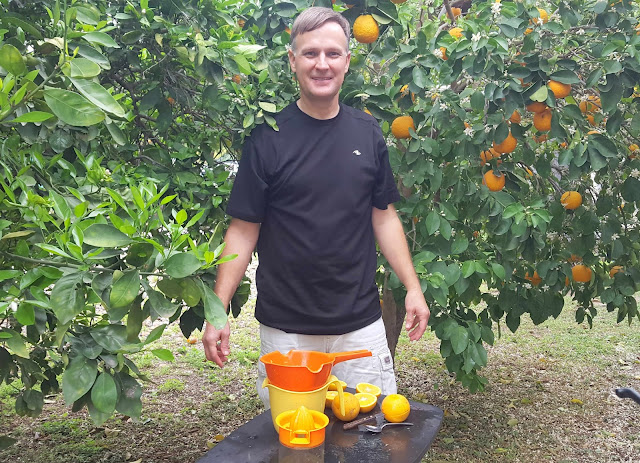We've said it before, and we'll say it again--we love the wonderful citrus we get to enjoy while we visit Bentsen Grove campground in South Texas! We love to eat oranges, tangerines, and grapefruit that are tree-ripened and just minutes after they are picked. Denisa's Mother has asked us to pick all her fruit so it won't fall off the trees and spoil. So Mark has been spending some good quality time at the top of the ladder, as well as doing his monkey imitation in the limbs of her fruit trees.
We will get to take much of that fresh fruit with us when we leave. We have also picked some of the oranges on our lot. Even though Denisa has been shooing those pesky black birds away, they are doing major damage to our fruit crop. They sit at the top of the tree, pecking holes in the best fruit and then eating it until only the rind is left.
In an effort to beat the birds to the fruit, we are juicing some of the oranges on our lot. Within minutes after picking, we can juice and freeze quart bags of orange juice. We are learning the most efficient method, as we set up the juicing station right under the trees. The oranges have seeds, so we squeeze them by hand into a colander. Fast and easy, and the sticky mess stays outside!
Besides the birds, we are finding that the bees are very interested in our fruit. The longer we juice, the more bees show up to drink from the just-cut orange halves.
Denisa had to wash her sticky juicing hands to take pictures of the bees one day. You can actually see this guy drinking the juice!
Because we like a little scientific experimentation, we tried to determine which tree had the best juice oranges. We picked ten oranges from two different trees, and found out they made exactly the same amount of juice. After we both did a blind taste test, we were relieved that our favorite was from the tree that we had already juiced the most. Whew! Being a scientist can be a tasty experience.
One of the best parts of our outdoor laboratory is the smell. We wish we had smell-a-blog capabilities, because citrus blooms are Denisa's favorite fragrance in the entire world. (Mark likes it too, but it is a distant third behind the smells of baking bread and grilling steaks for him.) These little blooms are especially concentrated at our motor home, where two trees are in full bloom right by our door. Simply opening a window gives the same effect as lighting her favorite scented candle.
Our juicing table has to be cleaned off every day, just to clear off all the blooms that are falling off the trees. It feels like summer with temperatures in the 80's, but it's looking like winter with the white blooms falling like snow.
We have learned more scientific knowledge about citrus trees this winter. Most fruit trees use a base from a strong rooted tree, with a good fruit tree grafted on top. They combine to give a strong rooted tree that bares tasty fruit. But we have one tree in which the good fruit top section was frozen years ago. That means that the root stock has taken over. The picture below shows the stunted and frozen graft with a single limb going off to the left. The other two healthy-looking straight trunks came up below the graft from the root stock.
Those two straight trunks are straight off the good root orange tree base, which is obviously a terrible orange fruit tree. The fruit off those two trunks is bumpy, and tastes like battery acid.
The lone branch above the grafted trunk has smooth skin fruit. We discovered they are actually lemons, and quite tasty!
To further our education, we have even learned about orange in our Spanish class. We now know that the Spanish word for the color orange is "anaranjado," while the word for the orange fruit is "naranja."
We enjoy living in a citrus orchard, and we'll miss the tastes and smells of this place when we leave. But we'll take a little taste of the valley with us when we leave with a freezer full of orange-colored orange juice! Or as we would say in Spanish class, some tasty "anaranjado naranja" juice.










No comments:
Post a Comment